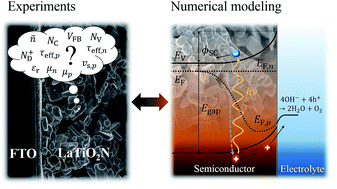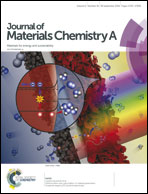Determination and optimization of material parameters of particle-based LaTiO2N photoelectrodes†
Abstract
We developed a validated numerical model capable of predicting the photocurrent–voltage characteristics of oxide and oxynitride particle-based photoelectrodes and identifying the critical parameters affecting the performance of those photoelectrodes. We used particle-based LaTiO2N photoelectrodes as the model system. Two different types of electrodes were studied: LaTiO2N photoelectrodes with TiO2 inter-particle connections and the same photoelectrodes with NiOx/CoOx/Co(OH)2 co-catalysts and a Ta2O5 passivation layer. The necessary material parameters, namely complex refractive index, permittivity, density of states of the conduction and valence bands, charge mobilities, flatband potential, doping concentration, recombination lifetimes, and interfacial hole transfer velocity, were derived by density functional theory calculations, dedicated experiments, and fitting of the numerically determined photocurrent–voltage curves to the measured ones under back-side illumination. The model was validated by comparing its prediction to front-side illumination photocurrent–voltage measurements. A parametric study was then carried out to provide an extensive set of material design guidelines and key parameters for high-performing particle-based LaTiO2N photoelectrodes. The interfacial hole transfer velocity was identified as the most significant parameter for the performance of LaTiO2N photoelectrodes.



 Please wait while we load your content...
Please wait while we load your content...